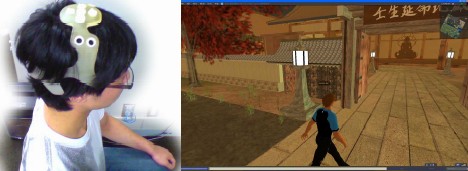
While recent developments in brain-computer interface (BCI) technology have given humans the power to mentally control computers, nobody has used the technology in conjunction with the Second Life online virtual world -- until now.
A research team led by professor Jun'ichi Ushiba of the Keio University Biomedical Engineering Laboratory has developed a BCI system that lets the user walk an avatar through the streets of Second Life while relying solely on the power of thought. To control the avatar on screen, the user simply thinks about moving various body parts -- the avatar walks forward when the user thinks about moving his/her own feet, and it turns right and left when the user imagines moving his/her right and left arms.
The system consists of a headpiece equipped with electrodes that monitor activity in three areas of the motor cortex (the region of the brain involved in controlling the movement of the arms and legs). An EEG machine reads and graphs the data and relays it to the BCI, where a brain wave analysis algorithm interprets the user's imagined movements. A keyboard emulator then converts this data into a signal and relays it to Second Life, causing the on-screen avatar to move. In this way, the user can exercise real-time control over the avatar in the 3D virtual world without moving a muscle.
Future plans are to improve the BCI so that users can make Second Life avatars perform more complex movements and gestures. The researchers hope the mind-controlled avatar, which was created through a joint medical engineering project involving Keio's Department of Rehabilitation Medicine and the Tsukigase Rehabilitation Center, will one day help people with serious physical impairments communicate and do business in Second Life.
(For video of the Second Life BCI, check the links on the Ushida & Tomita Laboratory news page, right above the first photo.)
[Source: Nikkei Net]

Mac
Trouble is, *thinking* about performing an action is still different than actually doing it. You still won't have the sense of "being there" that this kind of research suggests. Worse yet, that kind of experience is impossible without somehow suppressing your real-world responses. If I raise my hand, my actual hand will go up, regardless of how my avatar responds to the impulse.
Interesting, but not anywhere close to the sort of thing most people will assume it implies (IMHO).
[]Doc
What you forget is the topic of immersion. Have you ever been so into a movie or game that you forget time is passing? Or what the color of the walls are? For a lot of people these games give that feeling that they seek. "Being there", is immersion and its incredible for those who experience it.
[]Boris Anthony
@Mac: What you are thinking of, and what subsequently leads you to assume everyone is, is full immersion: transfer or your consciousness into the avatar. You are correct to say that one should not confuse that with this, which is direct control of an external entity (be the avatar a purely software based one, such as your double in Second Life) or a phsyical one (we already have implant tech that allows monkeys to control robotic hands) via EEG monitoring... which is still damn cool, IMHO. ;)
[]Dwayne
I would love to have that.
[]anonymous
this is amazing and will lead to improvements in the quality of life for many with limited physical capabilities. sl already has done this with paraplegic friends. just amazing work
[]Freebird2k
Would be cool to have virtual keyboard and type away using your mind.
I can't wait this to support battelfield 2/2142.
[]Spacer
Mac's post that "... *thinking* about performing an action is still different than actually doing it." is actually both correct and incorrect. When we walk to the shop we don't think about our balance, about breathing, about the movement of feet. When we were young we had to (well maybe not breathing but perhaps if you go back early enough....). We do this things automatically as we have learnt how to string such thoughts/impulses together. Games are actually how children learn and improve balance and motion and so on. Having such a tool integrated into a game is a good way to help this technology advance.
[]taph
I think this is a great news. As a disabled myself, I think it's great there are people working on technologies like this one. I play massive multiplayer online role-playing games, not Second Life though, and I do not have too much trouble but with my disease it can make me worse and I fear I would lose my favorite hobby where I get the chance to socialize online and do all those things regular people do which I wouldn't be able to do in real life. I get to be at the same level for once with everyone else. I have troubles though with other videogames where the devs have made over complicated controls, they have completely forgotten that games are supposed to be FUN. Such a device would be great.
[]MachinimaLover
That's AMAZING... Making machinima in SL will be easier-- just think
[]Japanese Machinima http://www.youtube.com/watch?v=en1nzven7jA
gary maloney
The idea is that the device develops to a point where you feel yourself moving transcended from body sense. The topper is that you take in the sights as fast as your eyes move. You are really there.
[]